Tauberbischofsheim
Tauberbischofsheim is a German town in the north-east of Baden-Württemberg on the river Tauber with a population of about 13,200. It is the capital of the Main-Tauber district. It is a popular tourist destination due to the presence of numerous historical buildings, including substantial remains of the Medieval town fortifications.
Tauberbischofsheim | |
|---|---|
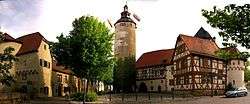 Centre of the town with the tower and castle | |
 Coat of arms | |
Location of Tauberbischofsheim within Main-Tauber-Kreis district 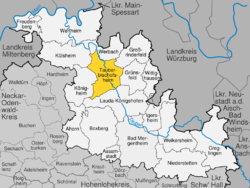 | |
 Tauberbischofsheim 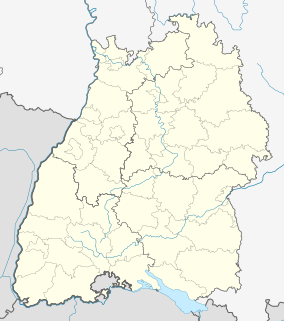 Tauberbischofsheim | |
| Coordinates: 49°37′21″N 09°39′46″E | |
| Country | Germany |
| State | Baden-Württemberg |
| Admin. region | Stuttgart |
| District | Main-Tauber-Kreis |
| Subdivisions | 7 Stadtteile |
| Government | |
| • Mayor | Anette Schmidt[1] |
| Area | |
| • Total | 69.31 km2 (26.76 sq mi) |
| Elevation | 183 m (600 ft) |
| Population (2018-12-31)[2] | |
| • Total | 13,231 |
| • Density | 190/km2 (490/sq mi) |
| Time zone | CET/CEST (UTC+1/+2) |
| Postal codes | 97941 |
| Dialling codes | 09341 |
| Vehicle registration | TBB, MGH |
| Website | www.tauberbischofsheim.de |
Tauberbischofsheim is also known for its fencers, who have won several Olympic medals and world championships.[3]
Geography
Location
Tauberbischofsheim is located in the Tauberfranken region of Franconia on the river Tauber.
Constituent Communities
Tauberbischofsheim consists of the main town of Tauberbischofsheim, as well as the Stadtteile Dienstadt, Distelhausen, Dittigheim, Dittwar, Hochhausen and Impfingen.[4] The boundaries of these Stadtteile are the same as that of the former independent municipalities.
Dienstadt has 335 residents and is located west of Tauberbischofsheim. Distelhausen has 983 residents and is located south of Tauberbischofsheim. Dittigheim has 1042 residents and is located south of Tauberbischofsheim. Dittwar has 788 residents and is located south-west of Tauberbischofsheim. Hochhausen has 788 residents and is located north of Tauberbischofsheim. Impfingen has 788 residents and is located north of Tauberbischofsheim.
History
Prehistory
The area was settled at least since around 3000 B.C., based on prehistoric finds.
Middle Ages
The town was first mentioned in a biography of Saint Lioba in 836. It bears its name ("bishop's place") due to its close relation to bishop Saint Boniface. Boniface brought his relative Lioba to the town around 735, where she became abbess of a monastery. Boniface founded the convent at Bischofsheim. In 1180 the town's oldest building, the Chapel of S. Peter, was built. Between 1237 and 1245 town rights were granted to Tauberbischofsheim. Around 1280 the Türmersturm-tower and the Kurmainz Castle were constructed. In 1318 the Bischofsheim market was first mentioned in official records.
16th to 18th century
From 1525 to 1627 the town was denied self-rule after picking the losing side in the Peasant's War. New municipal laws were introduced by Albrecht, Archbishop of Mainz, severely restricting citizens' rights. In 1629 Franciscan friars settled in Bischofsheim. During the Thirty Years' War Bischofsheim was under Swedish occupation from 1631 to 1635. In 1688 a Latin school was founded by the Franciscans. Later the school became the Matthias-Grünewald Grammar School.
19th century
In 1803 Bischofsheim was placed under the rule of the Prince of Leiningen, after having been part of Kurmainz for over 560 years. In 1806 Bischofsheim joined the newly created Grand Duchy of Baden. In 1823 the Franciscan monastery (Klosterhof) was dissolved. Around 1850 the town became known as Tauberbischofsheim. To distinguish the town from other towns named Bischofsheim, the name of the river Tauber was added to the name. The new town hall was built between 1865 and 1867. In 1866, a battle in the Austro-Prussian War took place in and around Tauberbischofsheim between troops from Württemberg and Prussia. Between 1894-95 the "Christuskirche" was built as a Protestant church. From 1910 to 1914 the Catholic Church of St. Martin was reconstructed.

20th century
The six Stadtteile were incorporated to Tauberbischofsheim during the local government reform in Baden-Württemberg in the 1970s: July 1, 1971: Hochhausen and Impfingen (1 July 1971), Dienstadt (1 January 1972) and Distelhausen, Dittigheim and Dittwar (1 January 1975).
History of the Stadtteile
 | Dienstadt | Dienstadt was first mentioned in 1314 as Diestadt, in 1341 it was renamed Dienstadt. |
 | Distelhausen | |
 | Dittigheim | Prehistoric grave finds from the Neolithic period show that the area has been inhabited for 4000 years. Dittigheim was first mentioned in 772. Dittigheim is home to the Baroque church of St. Vitus, which was built in 1748 by Balthasar Neumann, and several ornate shrines. |
 | Dittwar | Dittwar was first mentioned in 1169 as Ditebure (dit (mhd) = people / common / usually; bure (mhd) = farmer / neighbour) . The name evolved to Dydebuor in 1343, Dytbuer in 1368, Dietbur in 1371, Dytewure in 1383, Dietwar in 1407, and finally Dittwar in 1615. The first mention Dittwar is related to the donation of the Castrum Dietebure by Count Henricus de Luden to the Prince-Bishop of Würzburg. |
 | Hochhausen | Hochhausen was first mentioned in 780 in the Codex Eberhardi and the first written record of high Hausen dates back to 1149. |
 | Impfingen |
Governance
Mayors
The mayors of Tauberbischofsheim since 1945 were:[5]
- 1945–1946: August Haun
- 1946–1952: August Otto Bruch
- 1952–1958: Anton Baumann
- 1958–1972: Walter Grosch
- 1973–1980: Hans Dörfle
- 1981–1995: Erich Hollerbach (CDU)
- 1995-2019: Wolfgang Vockel
- since 2019: Anette Schmidt
Coat of Arms
In a red shield is a silver-white helmet crested by a wheel with seven spokes and attached by four ribbons ending in roses, all of the same colour.[6][7] According to source the archbishopric of Mainz gained the village of Tauberbischofsheim in 1237 and the fiefdom of a castle in 1316. The archbishops were rulers of the city until 1802. The helmet is symbolizing this fiefdom. The image was taken from seals and was not changed until 1740. 1865 some elements had been added. Over time, the old version was re-established.[7]
Arts and culture
Architecture
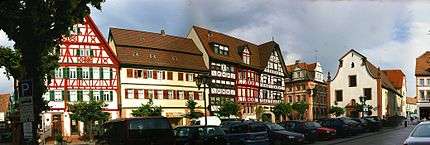
The old town, which was formerly completely surrounded by a defensive wall, features many historical buildings. The Tauberbischofsheim Castle dates back to second half of the 13th century. The marketplace is encircled by Half-Timbered houses and the Gothic Revival town hall. The parish church of St. Martin (German: Stadtpfarrkirche St. Martin) was completed in 1914 after its predecessor burnt down. The Gothic Revival church contains works of art from many past churches including an altar from the Ulm workshop of Niklaus Weckmann the Elder with panel paintings by Hans Schäufelein, a Madonna by Hans Multscher and a copy of the Tauberbischofsheim altarpiece by Matthias Grünewald. The oldest church in the city is the Peterskapelle, built in the 12th century. The Badischer Hof is the oldest hotel in Tauberbischofsheim. It was built in 1733.
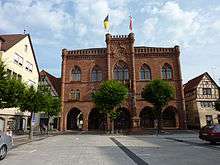
For many years the town was home to the Tauberbischofsheim altarpiece, a monumental piece of German renaissance art by Master Mathis now kept in the Karlsruhe Kunsthalle.
Museums
In Tauberbischofsheim and its suburbs there are the following museums:
Regular events
Every May there is a traditionally a "Maypole Festival" at Wörth place. In the same month there is an "Italian Night" at the market place.[13]
The "Tauberbischofsheimer Altstadtfest" (old town festival) is traditionally on the first weekend of July (Friday to Sunday).[14]
During Advent, the traditional "Tauberbischofsheim Christmas Market" is a popular meeting place on the castle square.[15]
Culinary specialties
Tauberbischofsheim and its environments are characterized in the lowlands by extensive fruit and wine growing areas. Here Tauber valley wines and sparkling wines are produced. Also beers (in the Distelhäuser brewery in the district Distelhausen), fruit brandies, regional cider and apple juice are produced. Regional specialties include Tauber-trout, Boeuf de Hohenlohe, Tauber valley country pig products, Tauber valley lamb and regional Grünkern.[16]
Sports
Fencing
The Fencing-Club Tauberbischofsheim[17] (commonly known as FC Tauberbischofsheim) is the most successful fencing club in the world, based on its medal successes in international sporting events.[3] The medalists were among others: Thomas Bach, Matthias Behr, Anja Fichtel, Zita Funkenhauser, Jürgen Hehn, Harald Hein and Alexander Pusch.[18][19] The FC Tauberbischofsheim is based in the Olympic team's training camp Tauberbischofsheim for the sport of fencing.[20]
Other sports
The TSV 1863 Tauberbischofsheim e. V is a popular sports club with 2,304 members (as of 2 October 2014) with eleven different departments for the following sports:[21] Football (soccer), Judo, Gymnastics, Badminton, Basketball, Table tennis, Tennis, Rock n roll, Volleyball, Handball and Karate.
Economy
Tourism
Tauberbischofsheim is located on the Romantic Road (German: Romantische Straße), a tourist route that connects many scenic cities and towns. The Romantic Road is the oldest tourist route in Germany. Tauberbischofsheim is also part of the Siegfried Road.[22]
Others
Diestelhausen is home to the Distelhäuser Brewery.[23]
Infrastructure
Transport
The Taubertalradweg along the Tauber River connects Tauberbischofsheim in one direction with Bad Mergentheim and Rothenburg ob der Tauber (in the other direction with Wertheim).
Health
The hospital Tauberbischofsheim has a public indoor pool with sauna and exercise pool.[24]
The solar-heated Frankenbad is a municipal swimming pool.[25]
Education
Town grammar schools in Tauberbischofsheim are the Christian-Morgenstern-Grundschule and the Grundschule am Schloss.
As far as general education is concerned, Tauberbischofsheim operates one college-track highschool or gymnasium (Matthias-Grünewald-Gymnasium) and two non-college-track highschools or Realschulen (Riemenschneider-Realschule, Pestalozzi-Werkrealschule). There is also one special-education school run by the town (Christophorus-Förderschule).
The Kaufmännische Schule Tauberbischofsheim (with Wirtschaftsgymnasium) and the Gewerbliche Schule Tauberbischofsheim are vocational schools or professional training schools run by the Main-Tauber-Kreis.
There are also two private schools: Volkshochschule Mittleres Taubertal e.V. and Euro Akademie Tauberischofsheim.
Notable people
Honorary citizen
- Emil Beck, (1935 – 2006), national fencing team head coach of Germany during many Olympic games and world championships
- Thomas Bach, (born 1953), since 2013 the ninth and current president of the IOC
Other people
- Leoba, (c. 710-782), established a convent in Tauberbischofsheim, where she became the abbess
- Richard Trunk (1879-1968), composer
- Reinhold Behr (born 1948), fencer
- Harald Hein (1950-2008), Olympic champion and world champion in fencing
- Hanns Jana (born 1952), fencer
- Matthias Behr (born 1955), Olympic champion and world champion in fencing
- Alexander Pusch (born 1955), Olympic champion and world champion in épée fencing
- Sabine Bischoff (1958-2013), fencer
- Gerald Ehrmann (born 1959), football goalkeeper
- Mathias Gey (born 1960), fencer
- Ulrich Schreck (born 1962), Olympic champion and world champion in fencing
- Anja Fichtel (born 1968), Olympic champion and world champion in fencing
References
- https://www.tauberbischofsheim.de/start/stadt+_+politik/buergermeisterin.html
- "Bevölkerung nach Nationalität und Geschlecht am 31. Dezember 2018". Statistisches Landesamt Baden-Württemberg (in German). July 2019.
- "Die Tauberbischofsheimer Medaillenschmiede: Erfolge des Fecht-Clubs Tauberbischofsheim". Fecht-Club Tauberbischofsheim e.V. Retrieved 2015-05-23.
- Stadt Tauberbischofsheim: Die Stadtteile der Kreisstadt Tauberbischofsheim Archived 2015-08-01 at the Wayback Machine. www.tauberbischofsheim.de. Accessed 19 October 2014.
- Franz Gehrig, Hermann Müller: Tauberbischofsheim. Verein Tauberfränkische Heimatfreunde e. V., Tauberbischofsheim 1997, p. 317–318 (Bürgermeister ab 1806).
- Zier, Hans Georg; Kastner, Julius Friedich: Wappenbuch des Landkreises Tauberbischofsheim, Fränkische Nachrichten, Tauberbischofsheim 1967.
- Fahnenversand: Coat of Arms of Tauberbischofsheim. www.fahnenversand.de. 22 May 2015.
- fnweb: Reformhaus schließt seine Pforten Archived 2015-09-24 at the Wayback Machine. Online at fnweb.de. Accessed on 17 March 2012.
- Bauernhofmuseum: Willkommen im Bauernhofmuseum-Distelhausen. Online auf bauernhofmuseum-distelhausen.de. Accessed 20 May 2014.
- Heimat- und Kulturverein Dittwar e.V.: Dorfmuseum. Online hkvdittwar.de. Accessed 13 October 2014.
- Wettin-Verlag – Werner M. Dienel: Hohenlohe-Franken „Das Schulmöbel-Museum“. Online at museen-in-hohenlohe-franken.de. Accessed 20 May 2014.
- Stadt Tauberbischofsheim: Tauberfränkisches Landschaftsmuseum im Kurmainzischen Schloss. Online tauberbischofsheim.de. Accessed 20 May 2014.
- Main-Post: Bella Italia auf dem Marktplatz. Online www.mainpost.de. 1 June 2014. Accessed 13 May 2015.
- Stadt Tauberbischofsheim: Altstadtfest. Online www.tauberbischofsheim.de. Accessed 9 November 2014.
- Weihnachtsmärkte Deutschland: Tauberbischofsheimer Weihnachtsmarkt. Online www.weihnachtsmarkt-deutschland.de. Accessed 13 May 2015.
- Liebliches Taubertal: Kulinarisches Profil. Online www.liebliches-taubertal.de. Accessed 13 May 2015.
- Vereinsregistereintragung VR67 beim Amtsgericht Tauberbischofsheim
- "Geschichte des Fecht-Clubs Tauberbischofsheim". Fecht-Club Tauberbischofsheim e.V. Retrieved 2015-04-29.
- "Die Tauberbischofsheimer Medaillenschmiede: Erfolge des Fecht-Clubs Tauberbischofsheim". Fecht-Club Tauberbischofsheim e.V. Retrieved 2015-05-02.
- "Olympiastützpunkt (OSP) Tauberbischofsheim – Die Medaillenschmiede". Fecht-Club Tauberbischofsheim e.V. Archived from the original on 2015-04-13. Retrieved 2015-05-23.
- TSV 1863 Tauberbischofsheim e. V.: TSV 1863 Tauberbischofsheim e. V. - Übersicht. Online www.tsv-tauberbischofsheim.de. Accessed 4 May 2015.
- Corinna Egerer, Michael Latzel: Tauberbischofsheim, Fränkische Nachrichten, Tauberbischofsheim 2005, page 139.
- "Distelhäuser Brauerei".
- Main-Tauber-Kreis: Hallenbad in Tauberbischofsheim. Online www.main-tauber-kreis.de. Accessed 23 May 2015.
- Stadt Tauberbischofsheim: Frankenbad. Online www.tauberbischofsheim.de. Accessed 23 May 2015.
Further reading
- Specialised books, scientific books
- Gerhard Finger, Erwin Heisswolf, Albert Krämer, Helmuth Lauf, Edgar Münch, Roland Veith: Tauberfranken: Lebensformen und Gesellschaftsordnung im Mittelalter. Fränkische Nachrichten, Tauberbischofsheim 1998, ISBN 3-924780-32-3.
- Carlheinz Gräter: Tauberbischofsheim. Fränkisch-Schwäbischer Heimatverlag, Oettingen 1968.
- Julius Berberich: Geschichte der Stadt Tauberbischofsheim und des Amtsbezirks. Mit einem Stadtplane vom Jahre 1790. M. Zöller’s Buchhandlung und Buchdruckerei, Tauberbischofsheim 1895 (Faksimile-Druck: Fränkische Nachrichten Druck- und Verlags-GmbH, Tauberbischofsheim 1984).
- Hugo Stang, Anton Ullrich, Wilhelm Ogiermann, Josef Kiefer, August Haun: Tauberbischofsheim. Aus der Geschichte einer alten Amtsstadt. Eigenverlag der Stadtverwaltung, Tauberbischofsheim 1955 (Chronik ohne die Zeit 1600 bis 1800).
- Gernot Wamser: Tauberbischofsheim. Sutton, Erfurt 2005, ISBN 3-89702-895-6.
- Corinna Egerer, Michael Latzel: Tauberbischofsheim. Fränkische Nachrichten, Tauberbischofsheim 2005, ISBN 3-924780-48-X.
- Franz Gehrig, Hermann Müller: Tauberbischofsheim. Verein Tauberfränkische Heimatfreunde e. V., Tauberbischofsheim 1997 (Schwerpunkt der Chronik: 1600 bis 1900).
- Dietrich Barsch, Werner Fricke, Peter Meusburger, Ulrich Wagner: Tauberbischofsheim und Bad Mergentheim. Eine Analyse der Raumbeziehungen zweier Städte in der frühen Neuzeit. Universität Heidelberg: Geographisches Institut, Heidelberg 1985, ISBN 3-88570-074-3.
- Emil Beck (Editor), Berndt Barth (Editor): The Complete Guide to Fencing, 366 pages, Publisher Meyer & Meyer, Aachen 2006, ISBN 978-1841261911.
- Manfred Maninger: Chronik der Gemeinde Dittwar. Heimat- und Kulturverein Dittwar e. V., Dittwar 1968.
- Elmar Weiß: Dittigheim: Eine alte Siedlung im Taubertal. Interessengemeinschaft Heimatbuch Dittigheim, Tauberbischofsheim 1987.
- Guides and maps
- Landesamt für Geoinformation und Landentwicklung Baden-Württemberg: Tauberbischofsheim: Bauland Unteres Taubertal. Landkarte. Freizeitkarte 1:50.000. LGL, Stuttgart 2009, ISBN 978-3-89021-605-8.
- Landesamt für Geoinformation und Landentwicklung Baden-Württemberg: Bad Mergentheim Tauberbischofsheim: Wanderkarte. Landkarte 1:35.000. LGL, Stuttgart 2009, ISBN 978-3-89021-776-5.
- Südwestrundfunk (ed.): Tour de Ländle 2012 : 27. Juli bis 3. August - die komplette Route von Tauberbischofsheim bis zum Europa-Park in Rust. Hampp-Verlag, Stuttgart 2012, ISBN 978-3-942561-14-3.
- Bikeline: Liebliches Taubertal: Der Klassiker - Der Sportive: Zwischen Rothenburg ob der Tauber und Wertheim. Esterbauer, Rodingersdorf 2013, ISBN 978-3-85000-463-3.
- Fairy tales and legends
- Hans Werner Siegel (ed.), Hugo Pahl: Zwischen Tag und Dunkel: Sagen u. Geschichten aus dem Taubergrund. Verein Tauberfränkische Heimatfreunde e.V., Tauberbischofsheim 1982.
- Directory and bibliography
- Richard Möll: Die Fecht-Legende von Tauberbischofsheim. Verlag Laub, Elztal-Dallau 1987, ISBN 3-88260-033-0.
- Claudia Wieland, Peter Müller: Hospital Tauberbischofsheim 1333–1965: Inventar des Bestands LRA 50 im Archiv des Main-Tauber-Kreises. Kohlhammer, Stuttgart 2000, ISBN 3-17-016063-X.
- Thomas Müller, Romana Schneider: Das Klassenzimmer vom Ende des 19. Jahrhunderts bis heute / The classroom from the late 19th century until the present day: Das Katalogbuch zum VS-Schulmuseum in Tauberbischofsheim. Wasmuth, Tübingen 2010, ISBN 978-3-8030-3348-2. (englisch)
External links
| Wikimedia Commons has media related to Tauberbischofsheim. |
| Wikivoyage has a travel guide for Tauberbischofsheim. |
| Wikisource has original text related to this article: |
- Official site of Tauberbischofsheim (in German).